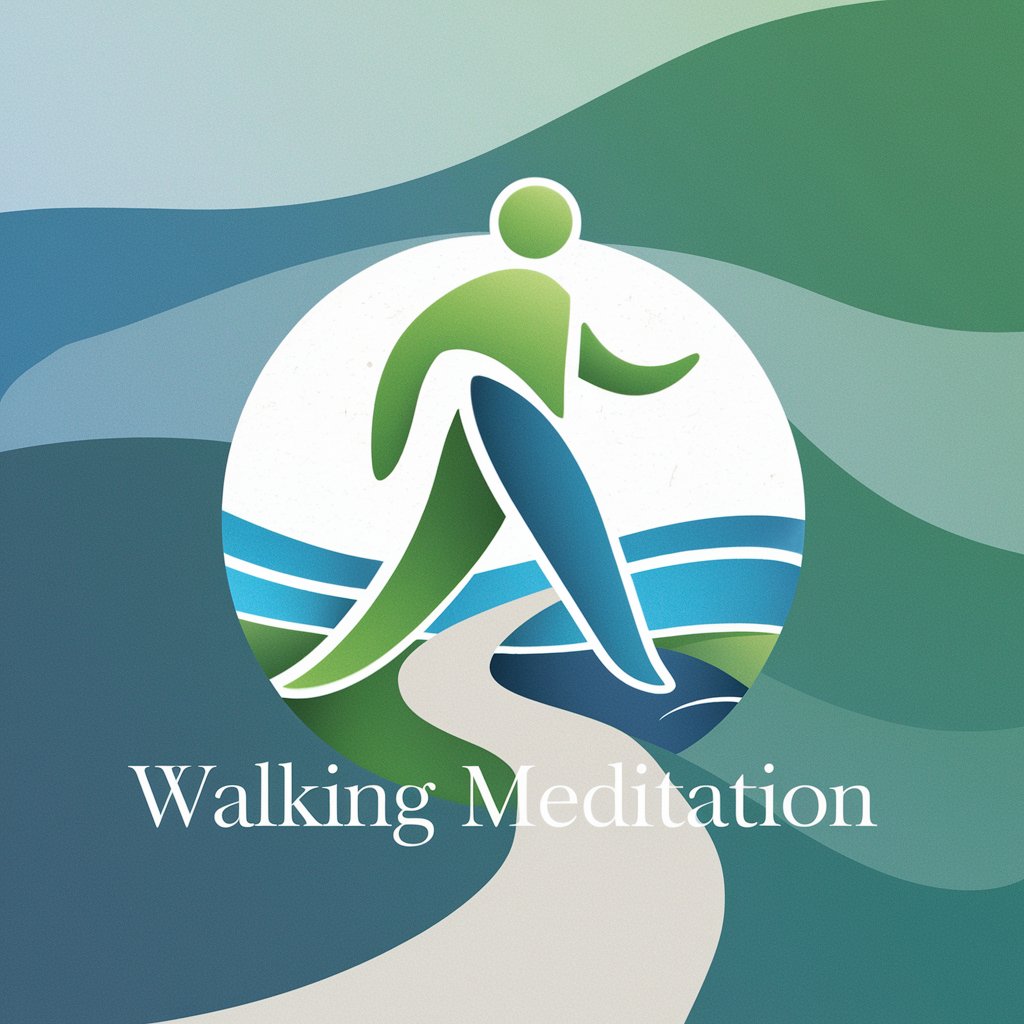Walking Meditation - Guided Mindfulness on the Go

Welcome to your walking meditation session.
Walk mindfully, live joyfully.
Begin by taking a deep breath and feeling the ground beneath your feet...
Notice the rhythm of your steps as you walk slowly and mindfully...
Focus on the sounds around you, letting each one come and go...
Feel the gentle movement of your body as you walk, staying present in the moment...
Get Embed Code
Introduction to Walking Meditation
Walking Meditation, as an AI-driven meditation guide, is designed to assist users in integrating mindfulness and meditation into their walking routine. Unlike traditional seated meditation, Walking Meditation focuses on the act of walking as the primary medium for mindfulness practice. This approach allows users to cultivate awareness, presence, and calmness while engaging in a natural, everyday activity. Through guided instructions, users are encouraged to pay attention to their breath, the sensations in their body, and their surroundings, transforming an ordinary walk into a meditative experience. An example scenario illustrating its purpose could involve a user feeling stressed and seeking a way to combine physical activity with mental relaxation. By engaging with Walking Meditation, they embark on a guided walk, during which they are prompted to notice the sensations of their feet touching the ground, the rhythm of their breath, and the sounds and sights around them, leading to a state of mindfulness and reduced stress. Powered by ChatGPT-4o。

Main Functions of Walking Meditation
Guided Walking Sessions
Example
A user receives step-by-step audio instructions tailored to their current environment (e.g., urban park, neighborhood street) and the session's theme (e.g., gratitude, letting go).
Scenario
A person seeks to clear their mind during a lunch break. They select a 20-minute guided walking session focusing on gratitude, during which they are guided to reflect on aspects of their life they are thankful for, enhancing their mood and mindfulness.
Customizable Session Parameters
Example
Users can adjust the duration, focus (e.g., breath awareness, sensory observation), and intensity (e.g., leisurely, brisk) of their walking meditation.
Scenario
An individual preparing for a stressful day ahead chooses a brisk, 30-minute walking meditation focused on breath awareness to energize and center themselves.
Integration with Daily Life
Example
Walking Meditation encourages users to engage in meditation without needing to carve out additional time in their day, by guiding them through mindfulness practices during their regular walks.
Scenario
A busy parent incorporates a short walking meditation into their routine while walking their child to school, turning a routine task into a moment of connection and mindfulness.
Ideal Users of Walking Meditation Services
Busy Professionals
Individuals with demanding work schedules who struggle to find time for traditional meditation sessions. Walking Meditation offers a flexible, efficient way to incorporate mindfulness into their day, enhancing mental clarity and stress management without requiring extra time.
Active Lifestyle Enthusiasts
People who prefer physical activity and are looking for ways to enrich their exercise routine with mental health benefits. Walking Meditation provides an accessible entry point to mindfulness, allowing them to combine physical activity with mental well-being practices.
Meditation Beginners
Individuals new to meditation who may find sitting still for extended periods challenging. Walking Meditation introduces them to mindfulness in a more dynamic and engaging way, making the practice more approachable and less intimidating.

How to Use Walking Meditation
Begin Your Journey
Start by visiting yeschat.ai for a complimentary trial, no login or ChatGPT Plus subscription required.
Choose Your Path
Select the Walking Meditation option to begin your guided meditation journey. Ensure you're in a safe, comfortable place where you can walk freely.
Set Your Pace
Adjust the settings to match your walking pace and preferred meditation length. This ensures a harmonious synchronization between your physical movement and the meditative guidance.
Engage with Guidance
Follow the audio cues and guidance for mindfulness and breathing techniques. Use headphones for an immersive experience and minimize external distractions.
Reflect and Repeat
After completing your walk, take a moment to reflect on the experience. Regular practice enhances the benefits, so consider integrating this into your daily routine.
Try other advanced and practical GPTs
Happy Paws Trainer
Train Smart, Bond Forever

Budget Buddy
AI-Powered Financial Guidance

The iPad Classroom
Empowering Educators with AI-Driven Creativity

Job Postings Co-Pilot
Crafting tailored job listings with AI

心の悩み解決ナビ
AI-powered mental health companion

DashAdvisor
Empowering Dash users with AI-driven insights

Assistente per la stampa 3D in Italiano
Empowering your 3D printing journey with AI.

Advanced Rust Assistant
Elevating Rust Development with AI

Tantra Guide
Empowering Intimate Connections with AI

The Wellness Manifesto
Empowering Your Wellness Journey with AI

Legal Tech Advisor | Smart Assistant for Law Firms
Empowering Law Firms with AI

Brofessional: Tulip Tech Guru
Empowering Tulip with AI Insight

FAQs About Walking Meditation
What is Walking Meditation?
Walking Meditation is a form of meditation in motion. Instead of sitting, practitioners walk slowly and mindfully, focusing on the sensations in their bodies or their surroundings, guided by structured audio cues.
Who can benefit from Walking Meditation?
Anyone looking for a mindful way to increase their physical activity, reduce stress, or improve mental clarity can benefit from Walking Meditation. It's suitable for all ages and fitness levels.
Can I practice Walking Meditation anywhere?
Yes, Walking Meditation can be practiced in any quiet, safe space where you can walk without obstacles. Popular locations include parks, gardens, or even a quiet room at home.
How often should I practice Walking Meditation?
Regular practice is key to reaping the benefits. Starting with a few minutes daily and gradually increasing the duration can help build a sustainable habit.
Do I need any special equipment?
No special equipment is required. Comfortable clothing and shoes are recommended, and using headphones can enhance the audio-guided experience.
